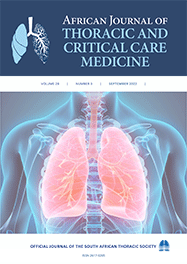Original research

A comparison of the functional parameters of operability in patients with post-inflammatory lung disease and those with lung cancer requiring lung resection
Abstract
Background. It is a common, yet unproven, belief that patients with post-inflammatory lung disease have a better functional reserve than patients with lung cancer when compared with their respective functional parameters of operability – forced expiratory volume in one second (FEV1), maximum oxygen uptake in litres per minute (VO2max) and the diffusion capacity for carbon monoxide (DLCO).
Objectives. The aim of this study was to compare a group of patients with lung cancer with a group with post-inflammatory lung disease according to their respective functional parameters of operability. We also aimed to investigate any associations of FEV1 and/or DLCO with VO2max within the two groups.
Methods. We retrospectively included 100 adult patients considered for lung resection. All patients were worked up using a validated algorithm and were then sub-analysed according to their parameters of functional operability.
Results. Two-thirds of patients had post-inflammatory lung diseases whilst the rest had lung cancer. The majority of the patients in the lung cancer group had coexistent chronic obstructive pulmonary disease (COPD) (n=18). Most (n=47) of the patients in the post-inflammatory group were diagnosed with a form of pulmonary TB (active or previous). Among the two groups, the lung cancer group had a higher median %FEV1 value (62.0%; interquartile range (IQR) 51.0 - 76.0) compared with the post-inflammatory group (52%; IQR 42.0 - 63.0; p=0.01). There was no difference for the %DLCO and %VO2max values. The lung cancer group also had higher predicted postoperative (ppo) values for %FEV1 (41.0%; IQR 31.0 - 58.0 v. 34.0%; IQR 23.0 - 46.0; p=0.03, respectively) and %VO2max (58.0%; IQR 44.0 - 68.0 v. 46.0%; IQR 35.0 - 60.0; p=0.02). There was no difference in the %DLCO ppo values between the groups.
Conclusion. Patients with lung cancer had higher percentage values for FEV1 and ppo parameters for %FEV1 and %VO2max compared with those who had post-inflammatory lung disease. Our findings suggest that lung cancer patients have a better functional reserve
Authors' affiliations
MH Amirali, Division of Pulmonology, Department of Medicine, Stellenbosch University and Tygerberg Academic Hospital, Cape Town, South Africa
EM Irusen, Division of Pulmonology, Department of Medicine, Stellenbosch University and Tygerberg Academic Hospital, Cape Town, South Africa
CFN Koegelenberg, Division of Pulmonology, Department of Medicine, Stellenbosch University and Tygerberg Academic Hospital, Cape Town, South Africa
Full Text:
Cite this article
Article History
Date published: 2018-04-03
Article Views
Full text views: 217
Refbacks
- There are currently no refbacks.
African Journal of Thoracic and Critical Care Medicine| Online ISSN: 2617-0205
This journal is protected by a Creative Commons Attribution - NonCommercial Works License (CC BY-NC 4.0) | Read our privacy policy.
Our Journals: South African Medical Journal | African Journal of Health Professions Education | South African Journal of Bioethics and Law | South African Journal of Child Health | Southern African Journal of Critical Care | African Journal of Thoracic and Critical Care Medicine| South African Journal of Obstetrics and Gynaecology |



.jpg)